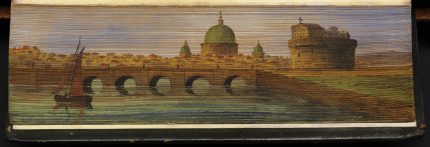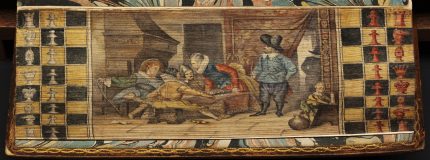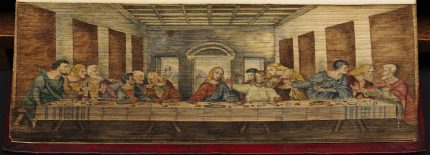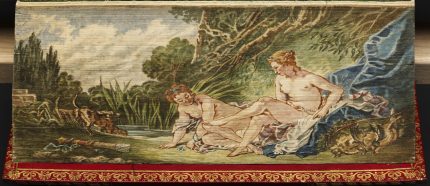
The Boston Public Library (BPL) has made available online more than 200 high-resolution photographs of its collection of exquisite fore-edge paintings. These are miniature masterpieces painted just inside the edge of the pages on the side of books. Some of them match the subject of the book; others are tributes to the wealthy aristocrats who commissioned them. All of them are gorgeous.
The idea of painting the outer page surface of a closed book took hold in the 17th century and became a popular trend for a while. It continued into the early 18th century but had largely fallen off the radar as the century came to a close. The Edwards family of Halifax, first William Edwards around 1755, followed by his even more innovative sons, revived the medium and turned it up to eleven.

John and James Edwards, sons of William, opened a bookshop on Pall Mall in London in 1784. They also maintained the family shop in Halifax which was much larger and may have been the place where some or most of the actual bookbinding for the Pall Mall shop was done. Both of the Edwards shops had a reputation for the elegance and quality of their bindings, but it was the London store that brought them the most rarified clientele of the age.
They used fine materials like calf leather, colored morocco, silk (for markers and end-leaves) and gold tooling to create expensive prêt-a-porter books and ultra-luxurious custom editions for bibliophiles and collectors from the staunchly respectable (vicars, scholars, assorted professionals) to the highest echelon of Britain society. Georgiana, Duchess of Devonshire, Marchioness of Rockingham and Queen Charlotte were repeat customers.

In 1785, James Edwards received a patent for a process to create transparent vellum that would line the covers and couple be painted or printed on the underside. This allowed books to be decorated to order with ink or pencil designs that would never rub off or smudge. The book’s front and back covers could be dusted and wiped clean with a wet cloth without any risk of the drawing on the delicate vellum lining would run. Family crests, monograms and initials were popular personalizations, on their own or accompanying figures drawn from the subject of the book.
The customized artwork of the vellum paintings neatly segued into fore-edge painting. Traditionally fore-edge paintings has been florals and heraldic motifs applied to the flat surface of the edge that could only be seen when the book was closed. The Edwards brothers eschews those limitations and created elaborate miniature widescreen panoramas of grand estates, landscapes, cityscapes, religious scenes, all applied to a thin sliver at the very edge of the pages so the pages had to be ever so slightly fanned out for the image to be seen. The painting became a sort of Easter egg, invisible when the book was closed because the outer surface was gilded; if the book was closed, all you saw was gold.
Their ambitious approach made bibliophiles swoon. Rev. Thomas Hartwell Home of the University of Cambridge described the technique in glowing terms in his 1814 book, An Introduction to the Study of Bibliography, Vol I:
To Messrs. Edwards, the lovers of ornamented books are indebted for a method of gilding upon marbled leaves, and decorating the edges of leaves with exquisite paintings; we have seen landscapes thus executed, with a degree of beauty and fidelity that are [sic] truly astonishing; and when held up to the light in an oblique direction, the scenery appears as delicate as in the finest productions of the pencil.
A Mrs. Thrale wrote about it in a letter to her daughter ca. 1812:
I have seen a newer – to me at least – a newer Method of displaying Elegance, in which, if you do not exceed all Your Competitors, it will be your own fault. Tis in Bookbinding – a White smooth Vellum cover to – [Mason] The English Garden – for example: must be painted with some Device relative to the subject on both sides – and the Leaves apparently gilt, must when you hold them in a particular manner – slanting, exhibit a beautiful Miniature Landscape painted likewise by the Lady; but concealed when the Book is shut. They are ten Guineas each, if you purchase; and Edwards of Pall Mall is the Owner of the Invention; but perhaps I am talking of a well known contrivance, which however surprized me.

We don’t know who painted the Edwards fore-edge mini-masterpieces. There are no signatures. Mrs. Thrale’s attribution of authorship to “the Lady” may have just been a groundless assumption on her part. Other accounts by people more closely connected to the Edwards suggest they were painted by one of the brothers, possibly John who made some of the finest of the vellum binding paintings.
Edwards weren’t the only bookbinders to create beautiful fore-edges. The Boston Public Library’s collection, amassed by Albert H. Wiggin in the second half of the 1940s, is the second largest in the country and the largest public collection. Its 258 volumes feature the work of several bookbinders and some of the most important fore-edge paintings extant, including a few very rare signed works.
Browse through the gallery here or click Browse to look through them by subject, category or title.
